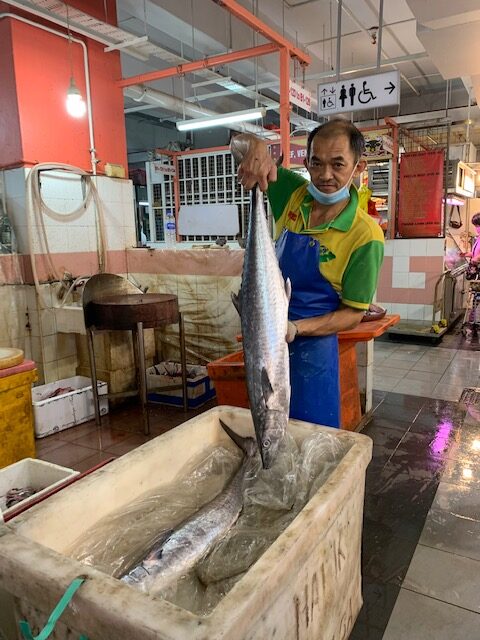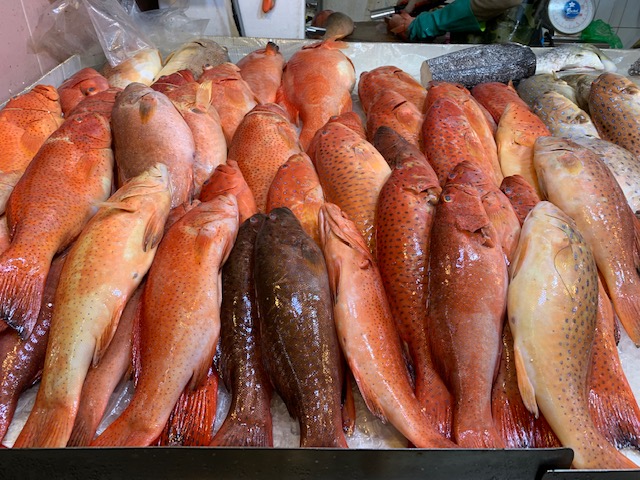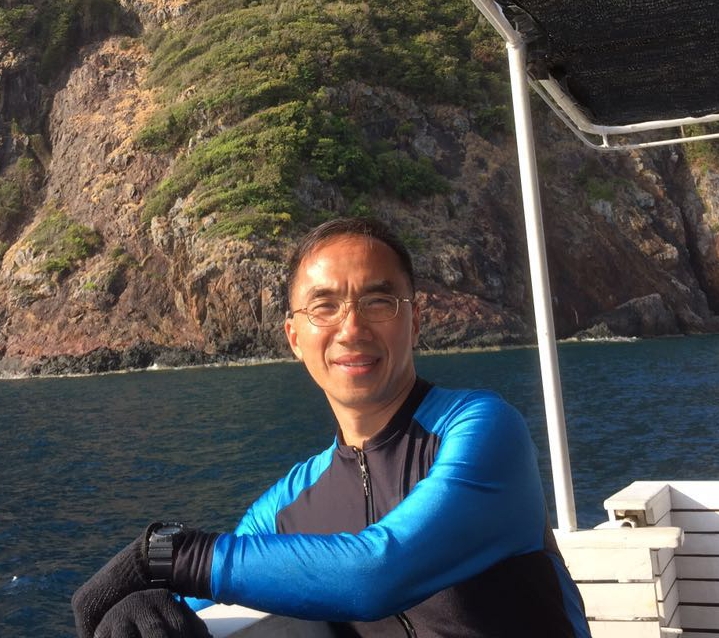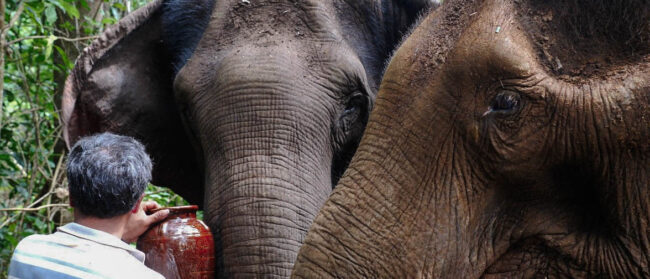The smell hits before the sight of Chinatown’s Wet Market comes into focus. The light whiff of mixed spices, the waft of sizzling local dishes from the nearby hawker stalls and the overpowering, unmistakable aroma of raw fish.
Beneath Singapore’s iconic concrete Chinatown Complex building, William Lim arrives hours before the market’s 8 a.m. opening to lay out his fresh wares, fins and tails aligned, across ice-laden polystyrene trays. His grouper are semi-local (“some from Singapore, some swim here from Malaysia, all good steamed”) and a key part of his livelihood.
Singapore currently produces 8% of its seafood locally and as climate change concerns mount and the Ukraine-Russia conflict exacerbates disrupted supply chains, the import-reliant Red Dot is upping efforts to increase its food security. In support of the government’s ‘30 by 30’ aim to produce 30% of the country’s nutritional needs by the end of the decade, the Singapore Food Agency recently announced plans to set up fish farms next to coral reefs off three of the Lion City’s islands: Pulau Satumu, Pulau Bukom and Pulau Jong.


While Lim and his peers are ambivalent (“no need, lah. Malaysia just nearby”) it’s estimated that boosting the country’s aquaculture could significantly improve food ecosystem sustainability. Local aquaculture production accounted for around 9% of Singapore’s 2021 fish consumption and new sites could produce an estimated 22,260 tonnes of fish annually.
The decision has met pushback over environmental concerns, with public consultation of an environmental impact assessment extended from 1 June to 15 June deadline.
Southeast Asia Globe spoke to Matthew Tan, co-chair, sustainability, at the Asia-Pacific Economic Cooperation (APEC) and Asia CEO of sustainable fish farm provider, Assentoft Aqua about fish baby booms, introducing new agricultural technologies and aquaculture’s vital role in Singapore’s food security and self-sufficiency.

What are your views on the recent announcement of new fish farms built around Singapore’s coral reefs?
A delicate balance is needed when you deliberate on the locating of floating cage farms in close proximity with coral reefs: weighing national food security goals versus possible arising environmental degradation issues. With the climate change challenges (especially global warming) I believed that close-contained farming methodology or land-based aquaculture farm[ing] is the long-term solution and the way forward for the industry.
Why is food security an especially urgent issue for Singapore?
In Singapore, 90% of our food is imported. Especially in the aquaculture industry, where I come from, we are only producing 5%, Singapore consumes about 100,000 metric tonnes (110,231 U.S. tons) of fish alone. And the last record for the year 2020 shows we are only producing less than 4,000 metric tonnes (4,409 tons) excluding shellfish. So as you can see, Singapore is very dependent on import.
So food security is important. Because if the Covid continues, more lockdowns, I think, we’ll get in trouble very soon. If you look at the current conflict in Ukraine it’s not helping the case. Ukraine is a major producer of grain. And if this continues, there’ll be a whole chain effect. Grain is also used as animal feed. So there will be a problem.
Then we had the grid saga at the Suez Canal, where the Ever Given was stuck. For six days, the whole world came to a stop, because the supply chain was not able to move.
At any time, if there is another outbreak, another Covid, another similar situation, we may not last more than maybe a month, or less. [The government’s] 30 by 30 is to ensure Singapore is self-sufficient for 30% of its protein needs.
How can aquaculture help move Singapore towards more sustainable maritime and marine food security?
Fishing trawlers are catching fewer and fewer fish. There are a few reasons [for this]. One, because of global warming. As the ocean gets warmer fish have only a two degrees tolerance. What will happen is the surviving fish dive deeper and they are going to swim towards the poles.
I was just talking to a tuna fishery company in one of the Asian countries. And they said “Matthew, look at the sonar. The fish are here, but our nets cannot reach them.”
If they continue fishing at this current rate, which is not sustainable, World Wildlife Fund WWF forecasted by 2048 there will be no more fish left in the ocean. I’ve presented [research] on a concept agreement between the aquaculture industry and the fishing trawler industry, where I proposed that every fishing trawler invests 1 million eggs into the ocean.
The technology for farming, aquaculture has gone down. And the techniques are more advanced so we can produce a lot more babies.
The idea is to restock the ocean. This has to be a private and public partnership where the public sector marks areas as marine reserves where there is strictly no fishing. We release the baby fish in these areas to let them replenish and grow again. I know of a project that was undertaken in the Philippines, where they grow the baby crab in a hatchery and put it aside in this marine sanctuary. Within three years, the macro population started appearing again.
Global warming is also taking a hit on the fishery and aquaculture industry. Norway and Chile are the number one and number two world’s largest producers of farmed salmon. But for the last six months, they’ve been hit by an algae boom. Global warming is causing the waters to get warmer, the water getting warmer is a conducive environment for the algae to grow. What happens is that in the process of the algae bloom, it actually sucks all the dissolved oxygen And that’s what causes a massive fish suffocation. That’s why Chile and Norway have suffered a massive loss.
Also as a result, because of the warming of the oceans, we are seeing an increase in disease from the pathogens from the increased bacteria, carbon and water. In the long run, unless we can quickly repair the damage to our ozone level and can seriously control greenhouse gas emissions, the oceans are going to keep getting warmer and warmer and warmer. Land- based farming may be the next sunrise in terms of production for food.
What needs to be done on the consumer side to influence greater awareness of sustainability and food security?
Global food loss and waste currently is about 30%. By the year 2050, the world population is expected to reach 9.7 billion. Now we’re at 7.7. A survey was done and they calculated that by the time we reach the year 2050, we will need 70% more food.
Lab-grown alternative proteins are currently just a bit too expensive. I know, because I am a mentor to one of the lab meat incubators. One kilogram costs about $1,800 (SGD 1,500). They hope to bring it to $361 (SGD 500). No matter what you say, price is everything.
The government is putting in grants, trying to encourage farms to automate, to use IoT, AI, robotics because it’s hard to find workers now. I really think that you need to invest in good technology. Back in 2008/2009 I was funded by the government to build Singapore’s first high-tech fish farm located in Pasir Ris. I was producing sea bass and grouper babies. The use of technology helped me so I was getting more baby fish than my then my neighbours, but my biggest problem was the technology made my cost of energy quite high. I used about 25 to 30 kilowatts to produce 1 kilogram of fish. Today, there are technologies out there in Europe that I know only use 1.5 kilowatts.
I believe that the use of technology to disrupt the industry is highly important. Because if you don’t use technology and you continue in the current way that Singapore is producing fish, you will be priced out. I met with a fish farmer and this farmer has a farm in Singapore, they produce sea bass. And he tells me that the cost of producing one kilogram of sea bass is about $5 (SGD 7). And it’s going to be hard for him to compete because our neighbours can import in the same seabass for 60% of the price.
What are the main solutions to boost Singapore’s food security?
I used to do a lot of consulting work in Africa before Covid. And the government there wants to curtail the import of fish to boost local production. They will put, say, a 10% tariff on imported fish. And then they take the 10% they give it to those farmers. If you produce locally, you get an incentive or a subsidy. To me, this is food security.
With the 30 by 30 initiative, some companies and the funds are looking at using technology to bring down the costs of production. We need to help our farmers bring the cost of production down. Then we can compete.
It is unlikely the government would consider putting tariff barriers. So instead of putting a tariff, the government is giving grants for the adoption of technology and digitisation. If upon adoption of this technology, you can increase your farming productivity, they will fund your automation. So I believe the government is doing a lot. What we need to do now is continue to encourage this local producer to not give up. Keep finding ways and means to bring down your costs of farming.
Photos by Amanda Oon for Southeast Asia Globe


